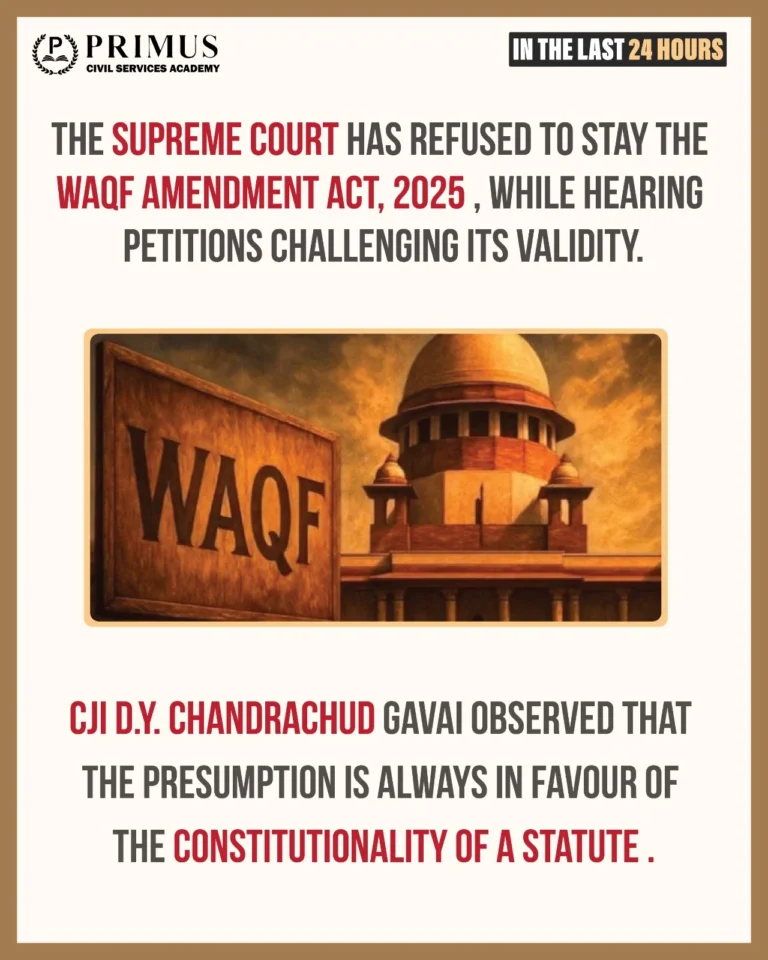September 15th Current Affairs
Table of Contents
NCERT History Textbooks
NCERT History Textbooks NCERT History for Class-VI (Social Science – Our Pasts-I) NCERT History for Class-VII (Social Science – Social
Kannada Literature Optional Syllabus
Home / ಐಚ್ಚಿಕ ಕನ್ನಡ ಸಾಹಿತ್ಯದ ಪಠ್ಯಕ್ರಮ ಐಚ್ಚಿಕ ಕನ್ನಡ ಸಾಹಿತ್ಯ ಪತ್ರಿಕೆ – 1 ವಿಭಾಗ – ಎ ಅ) ಕನ್ನಡ ಭಾಷೆಯ ಚರಿತ್ರೆ ಭಾಷೆ
UPSC Current Affairs – October 6th
October 06th Current Affairs Home / Table of Contents 36-hour curfew imposed in parts of Odisha’s Cuttack over communal tensions
Religious Minorities in India and the Challenge of Communal Harmony: A Sociological Reflection on the Cuttack Violence
Home / Religious Minorities in India and the Challenge of Communal Harmony: A Sociological Reflection on the Cuttack Violence Sociology
UPSC Current Affairs – October 4th
October 04th Current Affairs Home / Table of Contents Isabgol Processors threaten to halt purchases from October 6th over GST
Sologamy and Contemporary Trends in Marriage: A Sociological Perspective
Home / Sologamy and Contemporary Trends in Marriage: A Sociological Perspective Sociology Paper 1: Systems of Kinship – Contemporary trends
UPSC Current Affairs – October 3rd
October 03rd Current Affairs Home / Table of Contents NASA IMAP to show how solar particles are energised and shield
Understanding Indian Festivals through Durkheim: Religion, Rituals, and Collective Conscience
Home / Understanding Indian Festivals through Durkheim: Religion, Rituals, and Collective Conscience Sociology Paper 1: Émile Durkheim – Religion and
UPSC Current Affairs – September 30th
September 30th Current Affairs Home / Table of Contents Ladakh groups reject talks with government, Ministry says open to dialogue
Caste Census in India: A Sociological Perspective
Home / Caste Census in India: A Sociological Perspective Sociology Paper 2: Caste System – Features of Caste system. The
‘One Village, One Library’: Gadchiroli Police transform Maoist stronghold with 72nd library

Relevance to UPSC
GS Paper 1 — Society, Social Development
- Role of Education in Social Inclusion → Libraries bridge gaps of geography & conflict, reducing educational inequality.
- Community Participation → Local involvement sustains libraries, builds ownership & resilience.
- Empowerment of Marginalised Groups → Benefits women, tribals & unemployed youth in Maoist-affected villages.
GS Paper 2 — Polity, Governance, Internal Security
- Innovative Governance / Police as Development Agents → Police act as welfare providers, not just enforcers.
- Countering Insurgency via Welfare Measures → Development & education reduce support for insurgents.
- Decentralised Implementation → Libraries run through joint effort of villagers, police, CRPF, SRPF.
- Policy Implication → Shows need for tailored education schemes in conflict-affected regions.
GS Paper 3 — Security, Disaster Management
- Internal Security → Education & trust-building act as non-kinetic tools against Maoist insurgency.
- Human Resource Development → Libraries nurture skilled manpower, contributing to long-term stability.
More About the News
- The Gadchiroli Police have inaugurated their 72nd library under the “One Village, One Library” initiative, in Jijgaon (Mannerajaram police station), a Maoist‐affected area.
- Aim: To bring remote villages (especially in Maoist strongholds) into the mainstream by providing access to reading, competitive exam material, fostering education among students / unemployed youth / women.
- So far, 8,000 students are using these libraries; 205 students have been selected for various government jobs via support from this initiative. The libraries are community‐run, supported by police/CRPF/SRPF and local people.
Naxalism in India
The Union Home Minister, while paying tribute at the Amar Shaheed Smarak in Jagdalpur, Chhattisgarh, honoured the martyrs who sacrificed their lives in the fight against Maoist insurgency (Naxalism). He asserted that by March 2026, India will be completely free from the Maoist threat through a three-pronged “carrot-and-stick” strategy, which focuses on strengthening security measures, accelerating development initiatives, and ensuring empowerment of affected communities.
Evolution of Naxalism
- 1967: Origin in Naxalbari village, West Bengal, led by Charu Majumdar & Kanu Sanyal → peasants uprising against landlords.
- 1970s–80s: Spread across Bihar, Andhra Pradesh, Odisha; armed groups like People’s War Group (PWG) formed.
- 2004: Merger of PWG and Maoist Communist Centre → CPI (Maoist) became central organisation.
- 2006: PM termed Naxalism the “biggest internal security threat” (Red Corridor across 150 districts).
- 2010s onwards: Decline due to security operations, development schemes, surrenders; now confined to few districts in Chhattisgarh, Jharkhand, Odisha.
Causes of Naxalism
- Land Alienation & Inequality
- Unequal land distribution, bonded labour.
- Example: Telangana, Bihar landlords vs landless peasants conflict.
- Tribal Displacement & Resource Exploitation
- Large-scale displacement due to dams, mining, industrial projects.
- Example: Displacement in Chhattisgarh’s Bastar region due to mining projects.
- Poor Governance & Development Deficit
- Lack of infrastructure, schools, healthcare in tribal belts.
- Example: Villages in Dantewada with no road connectivity, exploited by Maoists.
- Social Injustice & Exploitation
- Marginalisation of Dalits, Adivasis; caste oppression.
- Example: Atrocities against Dalits in Bihar in 1970s-80s fueled Naxalism.
- Failure of Institutions
- Weak policing, corruption, slow justice delivery.
- Example: Delay in land reforms & forest rights implementation pushed tribals towards Maoist support.
Impact of Naxalism
- Security Threat
- Attacks on security forces, arms looting.
- Example: 2010 Dantewada massacre killing 76 CRPF personnel.
- Economic Disruption
- Destruction of infrastructure, halted mining/rail projects.
- Example: Frequent attacks on railway lines in Jharkhand.
- Human Cost
- Thousands of civilians, tribals, police killed.
- Example: 2021 Bijapur ambush killed 22 jawans.
- Governance Paralysis
- Parallel “janatana sarkars” (people’s govts) run by Maoists.
- Example: Bastar areas where Maoists run kangaroo courts.
- Stalled Development
- Investors avoid Red Corridor; welfare funds diverted.
- Example: Delayed projects in Left Wing Extremism (LWE)-affected Odisha districts.
Challenges in Tackling Naxalism
- Difficult Terrain & Intelligence Gaps
- Maoists exploit dense forests & mountains.
- Example: Chhattisgarh’s Abujhmad forests remain Maoist stronghold.
- Local Support to Maoists
- Tribals provide shelter, food due to grievances.
- Example: Support in Jharkhand’s Latehar district.
- Human Rights Concerns
- Security excesses, misuse of AFSPA/operations alienate locals.
- Example: Allegations during Salwa Judum movement.
- Socio-Economic Backwardness
- Persistent poverty makes Maoist ideology attractive.
- Example: High poverty in Gadchiroli, Maharashtra.
- Inter-State Coordination Issues
- Maoist corridors cut across state borders, hindering policing.
- Example: Border areas of Chhattisgarh–Telangana used as safe zones.
Government Initiatives
- Security Measures: Greyhounds, CoBRA battalions, Unified Command.
- Development Schemes: Integrated Action Plan (IAP), Aspirational Districts Programme.
- Surrender Policies: Financial packages, livelihood training for surrendered Maoists.
- Legislation: Unlawful Activities Prevention Act (UAPA), NIA Act.
- Infrastructure Push: Road Connectivity Project for LWE Areas.
Recommendations by Committees
- Expert Group (2008, Planning Commission): Focus on rights of tribals, land reforms.
- Justice Jeevan Reddy Committee (2005): Repeal AFSPA, ensure rights-based approach.
- K.S. Subramanian Committee: Police reforms, modernisation.
- NITI Aayog: Link security with socio-economic empowerment.
Way Forward
- Balanced Approach: Security + Development + Empowerment.
- Strengthen Governance: Speedy implementation of Forest Rights Act, land reforms.
- Improve Policing: Local recruitment, better intelligence networks.
- Tribal Empowerment: Education, healthcare, livelihood schemes.
- Dialogue & Rehabilitation: Encourage surrenders and peace talks.
Naxalism represents the clash between developmental deprivation and armed resistance. While security measures have reduced its spread, sustainable peace will come only by addressing root causes—land, livelihood, and dignity of tribals. A future-oriented strategy should ensure that by 2026 and beyond, governance and growth, not guns, define the Red Corridor.
Prelims MCQ
Q. Which of the following factors have contributed to the persistence of Naxalism in India? 1. Unequal distribution of land and resources 2. Lack of development in tribal and forested regions 3. Alienation of local communities from governance processes 4. External funding and cross-border support as the primary cause.
A. 1, 2 and 3 only
B. 2 and 4 only
C. 1 and 3 only
D. 1, 2, 3 and 4
Mains Question
Q. Naxalism in India is as much a socio-economic challenge as it is a law-and-order issue. Critically examine this statement and suggest a balanced strategy for addressing the problem.
Amid rising man-animal conflict, Kerala Cabinet proposes key changes to Wildlife Protection Act

Relevance to UPSC
GS Paper 1 — Society, Social Development
- Social Justice → Human-wildlife conflict causes loss of life & livelihoods of rural/forest-dependent people.
- Community Role → Local participation, forest rights & tribal rights vital for coexistence.
GS Paper 2 — Polity, Governance, Environment
- Legislative Reform → Kerala seeking more powers under Wildlife Protection Act, 1972; Centre–State angle.
- Administrative Responsiveness → Faster decision-making during wildlife threats.
- Policy Dilemma → Balancing animal protection with human safety.
- Legal Framework → Schedule I vs II classification impacts conservation priorities.
GS Paper 3 — Ecology, Biodiversity, Conservation
- Biodiversity Conservation → Reclassification of species (wild boar, macaque) alters ecosystem dynamics.
- Ecological Risk → Over-culling/vermin tag may trigger imbalance.
- Wildlife Management → Non-lethal options like relocation, sterilisation, habitat management.
- Agriculture & Food Security → Crop raids lead to farm abandonment
More About the News
- Kerala Cabinet Proposals → Amend Wildlife Protection Act, 1972; empower Chief Wildlife Warden to act quickly, allow state to declare certain Schedule II animals (e.g., wild boar) as vermin; shift bonnet macaque from Schedule I to II.
- Rising Conflict → 273 local bodies identified as hotspots; frequent crop raids and human-animal clashes escalating.
- Impact → From 2016–17 to 2024–25, 919 deaths and 8,967 injuries reported due to wildlife attacks in Kerala.
Wildlife Protection Act, 1972
The Wildlife Protection Act, 1972, is a landmark legislation that laid the foundation for wildlife conservation in India by providing a comprehensive legal framework for protecting species, habitats, and ecosystems. Enacted at a time when rampant hunting and deforestation threatened biodiversity, it unified fragmented state laws under a single national law. Over the decades, it has evolved to include stricter penalties, conservation authorities, and alignment with global treaties.
Evolution
- 1972 — Enactment: The Wild Life (Protection) Act enacted to protect wild animals, birds and plants; introduced schedules and a legal framework for protected areas and wildlife offences.
- Progressive amendments: Multiple amendments over decades strengthened penalties (2002), and created statutory bodies for specific tasks (2006 created NTCA and WCCB).
- Recent legislative activity: Several amendment Bills introduced in 2019 (and later 2021) to update the Act; major government amendment enacted in 2022 (Wildlife (Protection) Amendment Act, 2022).
Bodies / Departments / Authorities / Ministries involved
- Ministry of Environment, Forest & Climate Change (MoEFCC) — nodal ministry for wildlife policy and law.
- National Board for Wildlife (NBWL) — highest advisory body on wildlife established under the Act (advisory on policy, projects).
- National Tiger Conservation Authority (NTCA) — statutory body for tiger conservation (constituted under the Act).
- Wildlife Crime Control Bureau (WCCB) — intelligence & enforcement coordination for organised wildlife crime.
- Central Zoo Authority (CZA) — constituted under the Act for zoo regulation and ex-situ conservation.
- State Forest/Wildlife Departments & Chief Wildlife Wardens — frontline implementation & enforcement at the state level.
Major highlights & Schedules of the law
- Protected area provisions → Process for declaring sanctuaries, national parks and community reserves; controls on land use change.
- Schedules (I–VI) → Six Schedules listing species with varying protection levels (Schedule I & part II of II = highest protection with maximum penalties; Schedules III–IV = protected but lower penalties; VI = specified plant species).
- Offences & penalties → Prohibitions on hunting, trade and possession of scheduled species; enhanced punishments inserted by amendments (notably 2002).
- Statutory authorities → NBWL, State Boards, NTCA, CZA, WCCB established under the Act/its amendments.
Important amendments to the Act
- 2002 (effective 2003) — stronger penalties and stricter bail provisions for offences involving Schedule I / II species.
- 2006 Amendment (enacted 2006/2007) — created National Tiger Conservation Authority (NTCA) and the Wildlife Crime Control Bureau (WCCB) to strengthen implementation and anti-poaching coordination.
- 2019 legislative activity — multiple Bills were introduced in Parliament in 2019 by different MPs proposing changes; these reflect continued legislative interest though not all introduced Bills became Acts. (See Bill texts introduced in 2019).
- 2021–2022 Amendment (enacted 2022) — a government Bill introduced later resulted in the Wildlife (Protection) Amendment Act, 2022 (included measures to align with international agreements like CITES implementation mechanisms, recognition of additional species, and other updates).
Linkages with international agreements / conventions
- CITES (Convention on International Trade in Endangered Species) — WPA provides domestic legal framework to implement CITES obligations (controls on international trade in listed species).
- CBD (Convention on Biological Diversity) — WPA and related laws (Biological Diversity Act, 2002) implement India’s biodiversity commitments under CBD.
- Other multilateral instruments — (e.g., Ramsar for wetlands, CMS for migratory species) interact functionally with WPA implementation (via protected area designations and species protection measures).
Advantages of having the law
- Legal protection for threatened species — e.g., Schedule I protection for tigers prevents legal hunting & penalises trade; supports tiger recovery. (Example: Project Tiger enforcement aided by the Act).
- Framework for protected areas — enables creation of national parks and sanctuaries to conserve habitats (e.g., Jim Corbett NP, Kaziranga). (Example: habitat protection for one-horned rhino in Kaziranga).
- Stronger penalties deter wildlife crime — enhanced jail terms and fines reduce poaching & illegal trade (post-2002 amendments). (Example: convictions and seizures under WCCB coordination).
- Institutional architecture for focused conservation — creation of NTCA/CZA/WCCB enables targeted programs (e.g., NTCA supervising tiger reserves improves management). (Example: better tiger census and management guidelines).
- International compliance & trade regulation — empowers India to fulfil CITES obligations and control cross-border wildlife trade. (Example: regulation of ivory/animal part trade under domestic law).
Impacts of the law
- Species recovery — law + programs contributed to rising tiger counts (India’s tiger numbers increased substantially). (Example: All-India Tiger Estimation showing growth).
- Reduced poaching / organized trade — centralised enforcement (WCCB) improved coordination against trafficking. (Example: major seizures & arrests through WCCB operations).
- Habitat conservation — protected area network helped protect landscapes and associated biodiversity. (Example: expansion & management of tiger reserves).
- Community and livelihood conflicts — stronger protection sometimes led to human–wildlife conflicts and displaced access for local communities (challenging livelihood dependency). (Example: controversy over human access in reserve buffer zones).
- Legal basis for conservation governance — institutional bodies (NBWL, NTCA, CZA) improved policy coordination. (Example: NTCA’s role in Project Tiger management and standard setting).
Challenges Faced
- Human–wildlife conflict — legal protection can clash with human safety and livelihoods (e.g., rising conflicts in Kerala with boar/monkey incidents). (Example: Kerala seeking amendments to address conflicts).
- Enforcement & capacity gaps — states sometimes lack manpower/technology to prevent poaching or illegal trade. (Example: uneven enforcement across states; CZA probes of zoo management show oversight challenges).
- Centre–State coordination — wildlife is a concurrent/complex area requiring cooperation; disputes over species classification or actions can arise. (Example: Kerala’s repeated requests to change schedules for bonnet macaque).
- Socio-economic exclusion — forest-dependent communities & tribal rights can be adversely affected unless integrated (need for FPIC, CFR/Forest Rights Act linkages). (Example: tensions around relocation & compensation).
- Evolving threats (trade, habitat fragmentation) — illegal trade networks and landscape fragmentation need modern responses (tech, intelligence, cross-border cooperation). (Example: establishment of WCCB to tackle organized wildlife crime).
Best practices
- Namibia’s Communal Conservancies: community-owned conservancies that give financial benefits to locals, incentivising wildlife protection (reduces poaching & increases local buy-in).
- Costa Rica’s Payments for Ecosystem Services (PES): direct payments to landowners for forest protection that reduced deforestation and increased forest cover.
Way Forward
- Harmonise human-wildlife coexistence → adopt integrated conflict mitigation (ABC for problem species, compensation schemes, improved waste management, landscape planning).
- Strengthen community rights & benefits → link conservation incentives (eco-tourism, PES pilots) to local welfare.
- Enhance enforcement & intelligence → upgrade WCCB capabilities, forensic labs, data sharing and cross-border cooperation.
- Adaptive legal reform → periodically review schedules/penalties with scientific evidence, ensure due process & ecological safeguards.
- Science-based management → invest in monitoring (camera traps, population surveys), habitat restoration and landscape connectivity
As human-wildlife conflict and climate change intensify, the Act must move beyond protection to foster coexistence through technology-driven monitoring, community participation, and adaptive policies. Strengthening ecological corridors and integrating local livelihoods with conservation will ensure both biodiversity and human security. Thus, the Act’s future relevance lies in harmonizing development with sustainable conservation goals.
Prelims MCQ
Q. Consider the following statements about the Wild Life (Protection) Act, 1972: 1. The Act provides for six Schedules that classify species for differing degrees of protection. 2. The National Tiger Conservation Authority (NTCA) was constituted under an amendment to the Act. 3. The Act directly implements the provisions of the Convention on Biological Diversity (CBD) without any further domestic rules. Which of the statements given above is/are correct?
A. 1 and 2 only
B. 2 and 3 only
C. 1 and 3 only
D. 1, 2 and 3
Mains Question
Q. “The Wild Life (Protection) Act, 1972 provides the legislative backbone for wildlife conservation in India, but legal protection alone is insufficient to secure biodiversity.” Critically examine this statement with reference to institutional mechanisms, human–wildlife conflict, community rights and the recent amendments. Suggest a balanced policy approach.
Musk’s xAI lays off hundreds of data annotators: Report

Relevance to UPSC
GS Paper 1 — Society, Social Development
- Income Inequality → Marginal/contract workers in tech can be hardest hit; layoffs exacerbate precarity.
- Mental Health & Ethical Concerns → Sudden job loss, instability concerns; ethical dimensions of transparency in workforce management.
- Vulnerable Workers → Data annotators often in less visible, lower bargaining power positions—issues of justice, dignity of work.
GS Paper 3 — Science & Technology, Economy
- Automation & AI Displacement → Demonstrates how AI advances shift the nature of work and roles (from generalists towards specialists), causing job losses.
- Economic Efficiency vs Social Cost → Firms optimising operations may reduce costs but social consequences (job loss, inequality) need public policy response.
- Skills & Education → Need for workforce to adapt: domain specialisation, continuous learning to remain relevant in AI ecosystems.
More About the News
- xAI (Elon Musk’s AI startup) has laid off at least 500 data annotators/generalist AI tutors, its largest team, as part of a strategic reorganisation.
- The company is pivoting: reducing emphasis on generalist roles, to focus more on specialist AI tutors in domains like STEM, finance, medicine, safety. It plans to expand the specialist tutor team by ~10×.
- Affected employees were informed via email; their access to internal systems was revoked immediately though they will be paid through end of contract or until a specified date (November 30).
Unemployment
Unemployment reflects the inability of an economy to provide productive work opportunities for its workforce, despite their willingness and ability to work. The International Labour Organization (ILO) defines it as a situation where individuals of working age, without employment, are available for work and actively seeking it. It remains both an economic inefficiency and a social challenge, influencing growth, equity, and stability.
Key Trends in India
- Rural vs Urban: Higher unemployment in urban areas, especially among youth.
- Youth Unemployment: Persistent problem—educated youth face highest joblessness.
- Informal Sector Dominance: Majority employed informally; limited social security.
- Gender Disparity: Female labour force participation remains low (~25%).
- Structural Shifts: Agriculture’s share in jobs declining; services not absorbing enough labour.
Definition
International Labour Organisation (ILO) defines an unemployed person as “someone of working age who is without work, available for work, and actively seeking work within a specified recent period”
Types of Unemployment
- Cyclical Unemployment → Joblessness due to economic downturns.
- Structural Unemployment → Skills mismatch with industry demands.
- Frictional Unemployment → Short-term during job search/change.
- Seasonal Unemployment → Linked to agriculture, tourism, etc.
- Disguised Unemployment → More workers employed than necessary, esp. in agriculture.
- Technological Unemployment → Machines/automation replacing labour.
Disadvantages
- Economic Loss → Idle workforce reduces GDP (e.g., India’s youth unemployment wastes demographic dividend).
- Poverty & Inequality → Jobless households face deprivation (e.g., migrant workers post-COVID).
- Social Unrest → Protests, crime rise with frustration (e.g., job agitations in Haryana/Rajasthan).
- Brain Drain → Educated unemployed migrate abroad (e.g., Indian tech talent to US/EU).
- Mental Health Issues → Joblessness leads to stress, depression (e.g., rising suicides among educated unemployed in some states).
Impacts
- Slow Economic Growth → Lower productivity reduces long-term GDP growth.
- Fiscal Burden → Higher subsidies/welfare costs (e.g., MNREGA demand peaks in rural distress).
- Skill Degradation → Long-term unemployment erodes employability.
- Urban Migration & Overcrowding → Rural unemployed migrate, straining cities (e.g., slums in metros).
- Political Instability → High joblessness fuels populism & instability (e.g., youth-led political mobilisations).
Challenges in Tackling
- Jobless Growth → Automation + services-led growth not labour intensive.
- Skill Mismatch → 50% of graduates unemployable in industry jobs (India Skills Report).
- Informalisation → 80%+ in informal sector, without protections.
- Regional Imbalances → Bihar, UP high unemployment; southern states better.
- Policy Fragmentation → Overlapping schemes, weak coordination.
Government Initiatives
- Skill India Mission & PM Kaushal Vikas Yojana.
- Startup India & Atal Innovation Mission.
- MUDRA Loans to promote entrepreneurship.
- MNREGA as safety net in rural areas.
- PLI Schemes to boost manufacturing jobs.
Best Practices
- Global:
- Germany’s Dual Vocational Training System → integrates education & industry.
- South Korea’s Tech-Driven Job Strategy → focuses on innovation-based employment.
- India:
- Kerala’s Kudumbashree Mission → women’s self-employment & microenterprises.
- Gujarat’s Vibrant Skill Development Centres → industry-linked training.
Way Forward
- Promote labour-intensive manufacturing (textiles, food processing).
- Strengthen MSMEs and rural industries.
- Focus on future skills: AI, green jobs, digital economy.
- Improve female labour force participation.
- Ensure social security nets for informal workers.
- Promote entrepreneurship & startups in tier-2/3 cities.
Unemployment is not merely an economic challenge but a societal one, shaping aspirations and stability. With India poised to harness its demographic dividend, urgent action in skilling, job creation, and formalisation is essential. A future-ready strategy must integrate technology, sustainability, and inclusivity to generate resilient livelihoods.
Prelims MCQ
Q. With reference to unemployment in India, consider the following statements:
1. Disguised unemployment is most visible in the agricultural sector.
2. Cyclical unemployment is primarily associated with seasonal demand fluctuations.
3. Structural unemployment occurs when skills do not match industry needs.
A. 1 and 2 only
B. 1 and 3 only
C. 2 and 3 only
D. 1, 2 and 3
Disguised unemployment is common in Indian agriculture, where more workers are employed than needed. Structural unemployment is caused by skill mismatches. Cyclical unemployment is linked to economic recessions, not seasonal fluctuations.
Mains Question
Q. Discuss the challenges of unemployment in India in the context of jobless growth and demographic dividend. Suggest policy measures to align skill development, employment generation, and inclusive growth.
Supreme Court partly pauses Waqf Act as it prepares to hear pleas against it

Relevance to UPSC
GS Paper 1 — Society, Social Justice
- Impact on Minority Institutions & Autonomy → Waqf bodies are minority religious institutions; their autonomy is a sensitive issue.
- Social Inclusion vs State Oversight → Balancing need for transparency/accountability of waqf properties with rights of donors, religious community stakeholders.
GS Paper 2 — Polity, Governance, Constitution
- Constitutional Rights & Minority Rights → Questions raised about religious freedom, equality before law, and whether certain provisions violate Articles 14, 25.
- Separation of Powers → Supreme Court held that executive officers (Collectors) cannot adjudicate property rights—judicial forums must do so.
- Constitutional Validity of Legislations → Demonstrates how laws are scrutinised in courts for being arbitrary, discriminatory or violative of fundamental rights.
More about the News
- Supreme Court has partially stayed several contentious provisions of the Waqf (Amendment) Act, 2025, while keeping the rest of the Act in force.
- Key provisions stayed include:
• Section 3(1)(r) — requirement that a person must have practiced Islam for at least 5 years to create a Waqf.
• Section that empowered a designated government officer (Collector) to decide whether a Waqf property has encroached on state property. - Provisions not stayed but with judicial observations/limitations: inclusion of non-Muslims on Waqf Boards remains, but the court placed caps (e.g. not more than 3 non-Muslim members in State Waqf Boards, 4 in Central), recommended ex-officio members to be Muslim where possible.
Waqf (Amendment) Act, 2025
The Waqf (Amendment) Act, 2025 reforms the legal framework governing Muslim charitable endowments (waqfs) in India, aiming to improve transparency, governance, and accountability of these institutions. It replaces or amends various provisions of the previous Waqf Act, 1995, responding to long-standing issues like encroachments, litigation, and misuse. While intended to modernize waqf administration, it has sparked debates over autonomy, constitutional rights, and religious identity.
Evolution
- Originally regulated under colonial era law (Mussalman Wakf Act, 1923); post-Independence, the Waqf Act, 1954 established State Waqf Boards.
- Waqf Act, 1995 consolidated prior laws, established Central Waqf Council, required registration, audit, and protection of waqf properties.
- Amendment in 2013 modified some rules (e.g. strengthening penalties, registration etc.).
- Over time, complaints about mismanagement, encroachments, missing property records, lack of oversight; led to proposal of Amendment Bill in 2024, becoming Act in April 2025.
Major Highlights of the Act (2025)
- Only declaration or endowment allowed for formation of waqf; removal of “waqf by user” doctrine.
- Donor must be a practicing Muslim for at least 5 years and must own the property before dedicating it.
- Inclusion of non-Muslim members on State and Central Waqf Boards and Central Waqf Council; representation broadened.
- Digital modernization: Central Waqf Portal; digitization and GIS mapping of waqf properties; mandatory data upload by Mutawallis.
- Legal / governance changes: Waqf Boards’ composition altered; provisions for denotification of properties declared waqf by courts/deed/user; collector’s power to determine whether a property is government land.
How This Act Differs from the Previous Act (Waqf Act, 1995 etc.)
- Removal of “waqf by user” — earlier waqfs created by user were allowed; now abolished.
- Tighter conditions on dedication (donor must be practising Muslim for 5 years etc.) — stricter than earlier more liberal criteria.
- Greater State oversight, especially in property determination (Collector empowered to decide govt land etc.) — shifting some power away from Waqf Boards.
- Wider membership ⁄ inclusivity (non-Muslims, sect representation, women) vs earlier composition restricted more to Muslim community.
- Use of technology (digitization, GIS mapping, portal etc.) more emphasized than in the old Act.
Reasons for Bringing It
- Mismanagement and Encroachment — Many waqf properties illegally occupied and poor record-keeping; e.g. surveys pending in states like Gujarat, Uttarakhand.
- Litigation backlog and judicial delays — Disputes over ownership, unclear status of waqf by user or deed generated prolonged court cases; new law aims to clarify and expedite.
- Transparency & Accountability — Need to digitize records, audit accounts; prevent misuse of Section 40 (declaring private land waqf etc.).
- Inclusivity and Representation — Under-representation of women, sects, non-Muslim experts; new law aims to make Boards more inclusive.
- Protection of public / government land & prevention of false claims — To avoid haunted claims on government land as waqf; collector involvement and clear rules over “government land” status.
Concerns of the Act
- Autonomy vs State Interference — Critics argue that giving powers to Collectors or state bodies threatens the autonomy of waqf boards. E.g. Collector deciding whether land is government land.
- Religious Freedom Issues — Clause requiring donor to be practising Muslim for 5 years seen by some as discriminatory.
- Denotification & Loss of Rights — Properties declared waqf by courts, user etc. could be “denotified” if found to be government land, leading to loss of protection.
- Constitutional Validity under Fundamental Rights — Concerns re: equality (Article 14), freedom of religion (Article 25), minority rights. (Non-Muslim member inclusion, limits on autonomy).
- Implementation / Practical Issues — Digitization may be hampered by poor records; translation of law into ground action may face resistance; risk of misuse. Example: issues already seen in some state boards with vacancies or illegal use.
Impacts of the Act
- Improved regularization of Waqf properties — With clearer rules, many pending properties may get proper status. E.g. Central Portal and GIS mapping will help identify encroachments.
- Strengthened governance & oversight — better audits, inclusion of non-Muslim members, more checks may reduce corruption/mismanagement.
- Potential loss of some Waqf lands — If Collector rules government land, certain properties may lose waqf status. Could affect mosques, graveyards whose land status is disputed.
- Rise in legal /constitutional challenges & public protests — Already seen in Murshidabad violence, PILs; Supreme Court stays on some provisions.
- Increased transparency & modernization — Technology use, portals etc. may make waqf administration more accessible to beneficiaries. Eg uploading records, mapping properties.
Best Practices
Global:
- Many Muslim-majority countries like Turkey or Egypt have well-established waqf-registries, regular audits, strict state oversight yet with community autonomy. (E.g. Turkey’s waqf structure includes waqf boards with professional cadre and digital mapping). — analogous state-community balance.
- In Bangladesh, waqf welfare boards proactively auction or lease idle waqf land to fund welfare; including for public health, education. Good use of waqf assets.
Way Forward
- Ensure judicial oversight and remedy for denotification and Collector decisions to prevent arbitrary loss of rights.
- Implement digitization and mapping quickly and uniformly across states; ensure data is accurate & public.
- Set up grievance redress mechanism for religious institutions / mutawallis for clarity and protection of property rights.
- Educate communities & stakeholders about their rights under the new law; ensure transparency.
- Monitor constitutional compliance; possibly enforce sunset or review clauses for contentious provisions.
- Strengthen capacity of Waqf Boards (financial, technical) to adapt to new rules.
Going forward, the success of the Waqf (Amendment) Act, 2025 will depend not just on its legal provisions but on sensitive and fair implementation that respects religious autonomy while ensuring accountability. Judicial review and stakeholder participation are indispensable to ensure the law does not become an instrument of majoritarian overreach. If executed transparently, it has the potential to restore trust in waqf institutions and unlock their full social welfare potential.
Prelims MCQ
Q. Which of the following statements about the Waqf (Amendment) Act, 2025 are true?
1. It abolishes the doctrine of “waqf by user”.
2. It mandates that any dedication to waqf must be made by a person who has been practising Islam for at least five years.
3. It disallows inclusion of non-Muslim members in State Waqf Boards and Central Waqf Council.
A. 1 and 2 only
B. 2 and 3 only
C. 1 and 3 only
D. 1, 2 and 3
Statement 1 is true — the doctrine of “waqf by user” is removed under the new Act. Statement 2 is true — there is a requirement that the person dedicating the property has been practising Islam for at least five years. Statement 3 is false — the Act provides for inclusion of non-Muslim members in Waqf Boards / Council, rather than disallows them.
Mains Question
Q. The Waqf (Amendment) Act, 2025 attempts to reform waqf governance in India, but certain provisions raise serious concerns about religious autonomy and constitutional rights. Critically analyse the strengths and weaknesses of the Act. How should the state balance accountability with protection of minority rights?
To prevent future agitations by ‘vested interests’, Amit Shah orders study of protests since 1974

Relevance to UPSC
GS Paper 2 — Polity, Governance, Law & Order
- SOP & Rule of Law → Need for procedural clarity and uniformity in handling protests; balancing democratic rights with public order.
- Federalism & Centre-State Coordination → BPR&D working with state police / CID reports; implications for state autonomy in handling protests.
- Regulation vs Rights → Studying past protests to craft policy may risk chilling effects on freedom of speech, assembly.
GS Paper 3 — Internal Security
- Preventive policing / Intelligence gathering → Early warning signals via pattern/funding studies can help manage unrest.
- Financial networks & Extremism → Involving ED / FIU / CBDT shows link between protest funding, financial irregularities & possible harmful actors.
- Mass gathering safety → Religious gatherings are frequent; SOP can help prevent tragedies like stampedes.
More about the News
- Study of Protests: HM Amit Shah directs Bureau of Police Research & Development (BPR&D) to analyse major protests since 1974 — causes, funding, outcomes, patterns, and hidden actors.
- SOP Preparation: BPR&D to draft Standard Operating Procedures to prevent future mass agitations by vested interests.
- Inter-agency Coordination: BPR&D to work with state police, CID, ED, FIU-IND, and CBDT to trace financial aspects of protests.
- Mass Gathering Safety: Studies on religious congregations to prepare SOPs for monitoring and preventing stampedes.
- Focus on Punjab: NIA, BSF, NCB tasked with frameworks to counter Khalistani extremism and associated criminal-terror networks.
National Security Strategies Conference - 2025
The National Security Strategies (NSS) Conference 2025, inaugurated by Union Home Minister Amit Shah on July 25, 2025, in New Delhi, marked the eighth edition of this pivotal event. Held in a hybrid format, the conference brought together over 800 senior officers from across the country to deliberate on pressing national security challenges and formulate cohesive strategies to address them.
Evolution of the NSS Conference
- Initiated in 2016 following Prime Minister Narendra Modi’s directive during the DGsP/IGsP Conference to establish an annual forum for national security deliberations.
- The 2021 edition transitioned to a hybrid format, enabling broader participation from across the nation.
- The 2025 conference continued this tradition, emphasizing the integration of grassroots-level insights with strategic policymaking.
Major Highlights of the 2025 Conference
- Inaugural Session: Union Home Minister Amit Shah laid a wreath at the Martyrs Column, honoring the sacrifices of Intelligence Bureau personnel.
- Thematic Deliberations: Discussions centered on combating terror financing, narcotics trafficking, cyber threats, and enhancing forensic capabilities in investigations.
- Technological Integration: Emphasis on leveraging databases like NATGRID and NIDAAN for real-time intelligence sharing and coordination.
- Operational Strategies: Focus on strengthening district-level policing and fostering inter-agency collaboration.
- Policy Directives: Call for a “security-first” approach, habitual alertness, and proactive coordination among all agencies.
Reasons for Organizing the Conference
- Evolving Security Landscape: To address the multifaceted security challenges arising from India’s growing global stature.
- Enhanced Threats: To formulate strategies against emerging threats such as cyber warfare, radicalization, and transnational organized crime.
- Technological Advancements: To integrate advanced technologies and databases into national security frameworks.
- Policy Alignment: To ensure that ground-level operations align with national security policies and strategies.
- Capacity Building: To train and equip law enforcement agencies with the necessary tools and knowledge to tackle contemporary security challenges.
Impacts of the Conference
- Enhanced Coordination: Improved inter-agency collaboration, leading to more synchronized operations.
- Policy Formulation: Development of actionable policies based on grassroots-level insights.
- Capacity Building: Empowerment of law enforcement agencies through training and resource allocation.
- Technological Integration: Incorporation of advanced technologies into security operations, enhancing efficiency.
- Public Confidence: Strengthened public trust in the government’s commitment to national security.
Challenges Faced
- Resource Constraints: Limited resources hindering the implementation of proposed strategies.
- Technological Gaps: Challenges in integrating advanced technologies across all agencies.
- Coordination Issues: Difficulties in ensuring seamless coordination among diverse agencies.
- Policy Implementation: Barriers in translating strategic policies into actionable plans at the ground level.
- Public Perception: Addressing concerns regarding privacy and civil liberties in the implementation of security measures.
Way Forward
- Continuous Dialogue: Establishing regular forums for dialogue among security agencies and policymakers.
- Resource Allocation: Ensuring adequate resources for the implementation of security strategies.
- Technological Upgradation: Continuous investment in technology to stay ahead of emerging threats.
- Community Engagement: Involving communities in security initiatives to foster trust and cooperation.
- Policy Evaluation: Regular assessment of policies to ensure their relevance and effectiveness.
The NSS Conference 2025 serves as a critical platform for India’s security apparatus to converge, deliberate, and strategize on contemporary threats. By integrating insights from grassroots-level officers with strategic policymakers, the conference aims to fortify the nation’s security framework. Looking ahead, continuous adaptation to emerging challenges and fostering collaborative efforts will be pivotal in ensuring a secure and resilient India.
Prelims MCQ
Q.Which of the following databases was emphasized during the 8th National Security Strategies Conference 2025 for enhancing real-time intelligence sharing?
A. NATGRID
B. NIDAAN
C. Both A and B
D. None of the above
During the 2025 conference, both NATGRID (National Intelligence Grid) and NIDAAN (National Integrated Database on Arrested Narco-offenders) were highlighted as crucial tools for enhancing real-time intelligence sharing and coordination among security agencies.
Mains Question
Q. Discuss the significance of the National Security Strategies Conference 2025 in shaping India’s approach to contemporary security challenges. In your answer, analyze the key deliberations, the rationale behind organizing the conference, and the anticipated outcomes for national security.




